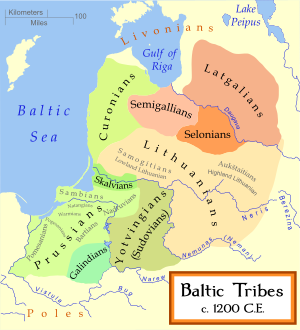Latgalians
This article needs additional citations for verification. (June 2017) |
| History of Latvia |
|---|
  |
| Chronology |
|
|
Latgalians (
They likely spoke a variant of
History
The Latgalians were an

In the 11th century,
Because of the crusade, many regions of Semigallia and Courland were left depopulated. Thus, part of the Latgalians migrated to those regions both during and after the war. Subsequently, between the 13th and 16th centuries, they gradually assimilated into the other Baltic tribes: the Selonians, the Semigallians and the Curonians. These formed the core of present-day ethnic Latvians.
Archaeological data

In the lands inhabited by Western and the Eastern Latgalians, about 80 flat cemeteries of Western Latgalian origin have been excavated, with more than two thousand burials uncovered. The first large scale excavations took place in Ludza Odukalns Cemetery in Latgale (1890–1891), where 339 Late Iron Age burials were uncovered. In the excavations at Pildas Nukši Cemetery (in Latgale, 1947–1948), 218 burials were uncovered, dated to the 9th to 12th centuries.
At the Zvirgzdenes Kivti Cemetery (in Latgale: 1948, 1955–1958), 175 burials from the 7th to 12th centuries were excavated. 315 burials were found at Aglonas Kristapiņi Cemetery (in Latgale; 1928, 1938, 1977–1980, 1984–1987, 1999–2000), in use from the late 8th century to the 12th century.
Ērgļu Jaunāķēni Cemetery was totally excavated in 1971–1972, with 89 burials found. At Koknese Cemetery, 102 burials from the Late Iron Age were uncovered (1986–1989). In the area of the Gauja river, two Latgalian cemeteries, Drabešu Liepiņas and Priekuļu Ģūģeri, have been excavated too.
Archaeological excavations have also been carried out on the hillforts of Ķente, Koknese, Sārumkalns, Tanīskalns, as well as on other Latgalian sites. Only a few (Western) Latgalian settlements have been excavated. Large-scale excavations (1960s–1970s) and reconstruction have been done at the Āraiši lake dwelling site (9th century).
In Latgale, dating from the 6th and 7th centuries, there were
Archaeologically-identified dwelling sites in
It is possible that ancestors of the so-called Eastern Latgalians migrated to the territory of present-day Latgale between the 7th and 11th centuries, pushed from their previously inhabited territory by
References
- ^ Humanities and Social Sciences: Latvia. University of Latvia. 2006. p. 24.
- ISBN 9780521833721.
